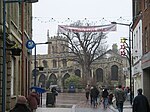Woodwalton Marsh
Sites of Special Scientific Interest in CambridgeshireWildlife Trust for Bedfordshire, Cambridgeshire and Northamptonshire reserves

Woodwalton Marsh is a 0.8-hectare (2.0-acre) biological Site of Special Scientific Interest north-east of Woodwalton in Cambridgeshire. It is managed by the Wildlife Trust for Bedfordshire, Cambridgeshire and Northamptonshire.This grassland on calcareous clay has diverse flora, including red fescue, quaking grass, knapweed, cowslip, pepper saxifrage, green-winged orchid and the rare sulphur clover. There is also a wide variety of butterflies.There is access from New Road.
Excerpt from the Wikipedia article Woodwalton Marsh (License: CC BY-SA 3.0, Authors, Images).Woodwalton Marsh
New Road, Huntingdonshire
Geographical coordinates (GPS) Address External links Nearby Places Show on map
Geographical coordinates (GPS)
| Latitude | Longitude |
|---|---|
| N 52.415 ° | E -0.221 ° |
Address
Woodwalton Marsh NR
New Road
PE28 5YT Huntingdonshire
England, United Kingdom
Open on Google Maps








